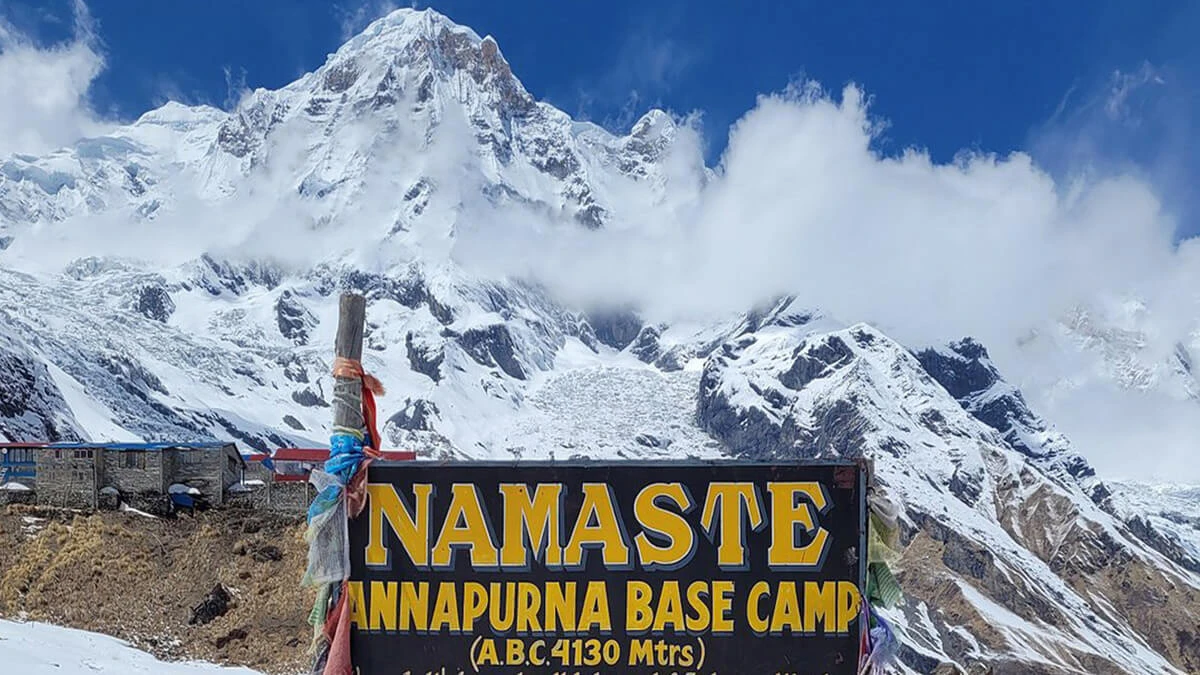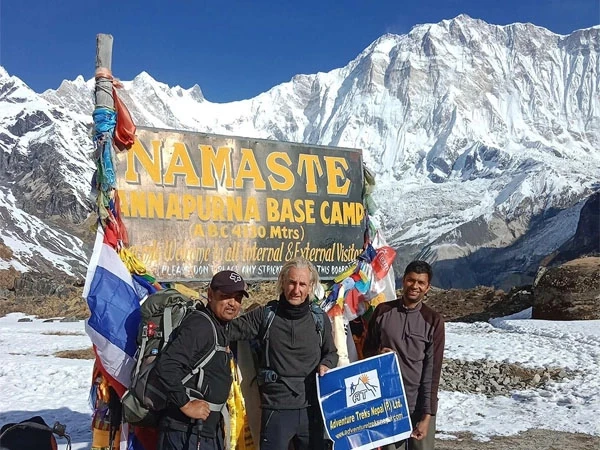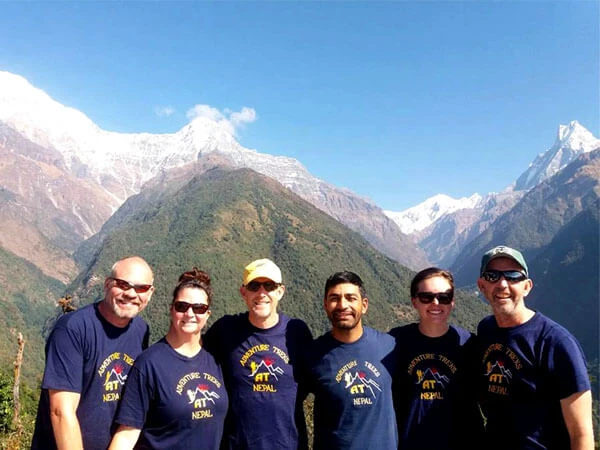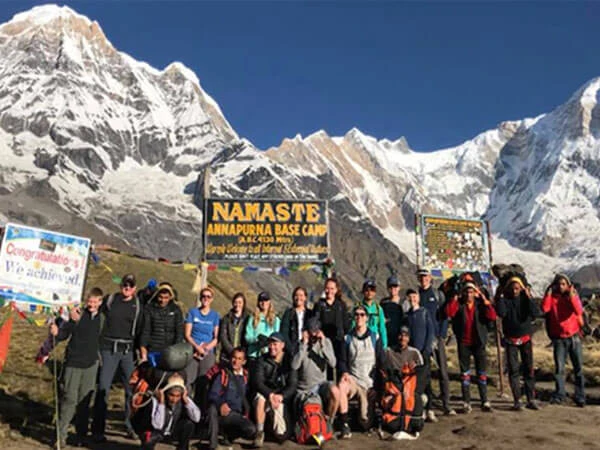What Is the Annapurna Base Camp Trek’s difficulty level?
Among numerous beginner-friendly treks in Nepal, the Annapurna Base Camp route is also one where, from a small child to an old person, anyone can easily walk and create lifelong memories in the core of the Annapurna region. This trek is generally considered moderate due to the nature of the trails and elevation gains during the journey. Factors contributing to the Annapurna Base Camp difficulty are as follows:
Does the altitude make the Annapurna Base Camp trekking challenging?
After driving to an initial point, Nayapul (1070 m) or Jhinu Danda (1760 m), trekkers will move through the trekking path by gaining altitude and occasionally losing elevation as the trail ascends and descends through diverse terrain. A rapid walk with insufficient acclimatization may lead to severe circumstances due to acute altitude sickness above 2,500 m.
Leaving the lush subtropical forests behind, trekkers at once reach the mountainous landmarks with thinner plants and alpine meadows, surrounded by towering Himalayas. While an environment showcases breathtaking scenery, lower oxygen levels affect stamina, making breathing more difficult.
Why Is Weather a primary component in ABC Trek Difficulty?
The weather of the alpine terrain might bring sudden snowfall, heavy rainfall, or strong winds in any season, although spring (March to May) and autumn are the best times to do the Annapurna Base Camp Trek. High-altitude topography has no certain weather and temperature due to high elevations.
If natural disasters such as floods, avalanches, or landslides occur while trekking, trekkers may need to take more strenuous alternative routes. In some cases, you might have to return to Kathmandu, as repairing the trail can take considerable time, especially at high altitudes.
Is the Rugged Terrain a Major Challenge on the Annapurna Base Camp Trek?
Most trails are well-marked, and several places along the Annapurna Base Camp route are easily accessible by transportation. While the overall hiking experience becomes enjoyable, you may find it difficult to walk on rugged terrain with steep ascents near the Base Camp. Secluded areas often have limited services, including accommodations and health posts in emergencies.
Accordingly, an injured person cannot receive immediate treatment in the absence of trained personnel and medical facilities. This journey is a golden opportunity to test your physical endurance since the topography along the way presents wonderful surprises alongside demanding challenges. All you will experience during this journey is spritual satisfactions together with exploration to most beautiful places. When you reach the base camp at an elevation of 4130 m, your efforts are worth it, and you can build the confidence to do another hike in mountainous landmarks that reach higher altitudes than this one.
Is covering the hiking distance a challenge on the Annapurna Base Camp Trek?
Walking for a prolonged period on the ABC route, covering approximately 65 to 115 kilometers, based on the chosen itinerary, may add challenges to the Annapurna Base Camp trekking. Trekkers with no prior hiking experience, including younger children and older family members, may find it challenging to navigate areas with steep climbs and technical descents.
Traveling by vehicle up to the furthest reachable point, you can reduce the entire trekking distance to Annapurna Base Camp. With proper physical fitness and mental preparation, it is possible to cover the full route without skipping any trekking areas.

Why Is Understanding the Annapurna Base Camp Trek Difficulty Essential?
Annapurna Base Camp trekking is not only about covering distances, connecting with native heritage, and soaking in scenic charms, but also about making one’s dream journey true by standing at the base of the tenth-tallest mountain. Therefore, safety is always a priority for successful completion. For proper preparation to follow the footsteps of legendary mountains up to 4130 m, you should know the Annapurna Base Camp Trek’s difficulty level, as various factors, including weather, trail conditions, trekking timing, and terrain, contribute to determining packing essentials and choosing an appropriate itinerary.
A well-planned odyssey will be safer and more enjoyable as it proceeds from warm, temperate green woodlands to high-altitude, cold mountain meadows. While understanding danger zones and the weather’s impact on the trail, you can wisely walk in such places with a gentle pace by adapting to the environment naturally.
As prevention is better than a cure, a seasoned guide is trained to handle all altitude-related issues and also carries a first aid kit, including medications like Diamox. With the right information, trekkers can mitigate the challenges of the Annapurna Base Camp Trek's difficulty grade.
What exercises do you need before the Annapurna Trekking?
Some simple training is essential to trek to Annapurna Base Camp for walking prolonged periods through the diverse landmarks of the Annapurna region. While involved in common cardiovascular training, such as walking, running, swimming, dancing, and cycling, you can improve the capacity of your heart and lungs and handle long walks at high altitudes.
Porters are available to carry your heavyweight backpack throughout the trip. Nevertheless, you can test your strength by carrying your weighted luggage yourself. Continuous walks with heavy bags are only possible when you do exercises like calf raises, lunges, and squats one or two months before venturing into hiking.
To sum up, although hard, Annapurna Base Camp trek training is not required for the trek; you should be ready like as you are going to traverse higher passes to prepare yourself to tackle the thinner air and some rocky, steep terrains, although there are no passes like Thorong La Pass (5416 m) of the Annapurna circuit trail.
Why is mental preparation important to tackle challenges on the ABC trek?
A physically fit trekker with a sound mind can easily complete the Annapurna trekking without panic on uneven trails. If you have patience and an encouraging perspective, the journey becomes enjoyable even when facing difficult conditions. Yoga practice or meditation can be beneficial for mental resilience to keep yourself optimistic on the route. Since a network is poor in secluded areas, carry some books, journals, comics, stories, and games to stay busy and avoid loneliness.
While spending a period in the Himalayas without contacting your parents, you might feel isolated. However, it is easier to deal with any situation after knowing the conditions of the routes. Accordingly, prepare yourself mentally, and do not expect advanced facilities in remote places on the Annapurna Base Camp trekking route.
Is the Annapurna Base Camp trek for beginners?
Novice trekkers can make it to the Annapurna Base Camp (4130 m), following the guide’s instructions and preparing well for long trekking hours. The journey becomes quite tougher for beginners than for an experienced hiker due to some steep sections of the route. However, strengthening the muscles of the legs will help every level of trekker to balance the body while traversing rocky terrain and glacial moraines near the base camp.
Beginners should be very careful above 2500 m since the thinner air may increase the chances of acute high sickness, deterring them from completing the trek. Hiring local porters and a trained guide through a reputable trekking agency in Nepal will be helpful for first-timers.
In conclusion, we have tailored packages of the Annapurna Base Camp trek for beginners by including sufficient acclimatization days. On your needs, you can make changes in the schedule because all itineraries are customizable.
Which Is Better: Annapurna Base Camp or Annapurna Circuit Route?
Both trekking routes are most preferred in the Annapurna region, as they provide similar scenery, including panoramic vistas of Mt. Annapurna, Gangapurna, Machhapuchhre, Tent Peak, and Dhaulagiri. The Annapurna Base Camp is shorter than the Annapurna Circuit route and is appropriate for families due to its hiking distance and duration. The Annapurna Circuit trail takes you to Thorong La Pass at an elevation of 5416 m, making it more strenuous than the ABC trek.
Nevertheless, the longer duration and greater hiking distance provide you with better opportunities for exploration. On the Annapurna circuit trek, you visit numerous Buddhist monasteries and beautiful villages like Manang, Chame, and Mustang, and several side trip options such as Ice Lake, Tilicho Lake, and Milarepa Cave are there If you want to extend the trekking.
Beyond the difficulty level of the Annapurna Circuit, you will get a golden chance to explore the sacred destination, Muktinath, which is revered by both Buddhists and Hindus. Similar to the ABC trek, the circuit route also takes you to Ghorepani Poon Hill (3210 m) for a breathtaking sunrise view. While the base camp trail reaches Jhinu Danda to relax at natural hot springs, the circuit path will lead you to Tatopani for the same experience.
In short, it depends on you how challenging you want the routes to be, as both the Annapurna Base Camp and circuit trekking trails are remarkable. However, choose the Annapurna Base Camp trekking If you want moderate-level trekking and want to complete it in 7 to 14 days.

Can a seasoned trekker handle the Annapurna Base Camp trek difficulty without a guide?
While observing the previous news, several local trekkers and foreigners experienced obstacles during the journey, including missing cases and death due to trekking with a guide. Visiting unknown places without a guide and a porter becomes very challenging, as natural disasters may sometimes force you to select an alternative way. In such a situation, only an experienced guide can guide you to turn to the right path.
Even if the rule for solo treks was in Nepal, we would suggest you hire them to navigate the path in a wise way without experiencing physical and mental strains.
How does travel insurance for the Annapurna trekking decrease mental stress?
Travel insurance plays a vital role in maintaining a budget for Annapurna trekking incase of necessity for expensive medical treatment and helicopter evacuation above 3000 m. While tackling the Annapurna Base Camp trek challenges, one can, with the right insurance, focus on the journey because of the assurance of coverage for unpredictable circumstances, including personal belongings lost or damaged, flight delay, or cancellation.
While processing for this kind of paperwork, choose a reputable company for reliable services. If you are thinking of doing budget trekking, obtaining travel insurance can be fruitful, as it covers rescue, helicopter evacuation, and treatment costs.
How can you prepare to avoid the Annapurna Base Camp Trek challenges?
Annapurna Base Camp Trek preparation is not only about packing essentials and equipment for the Himalayan adventure. You should consider several factors that can reduce the challenges on the ABC trail. We have provided some preparation tips to make the journey memorable for a lifetime regardless of the Annapurna Base Camp Trek difficulty grade.
- Do not forget the Annapurna Base Camp Trek map/GPS tool, compass, and essential trekking gear, together with layers (base, mid, and outer) and an extra sleeping bag for warmth in freezing temperatures at the base camp.
- Choose the best seasons, such as Spring and autumn, to avoid landslides, avalanches, and chilly winds that lead to worse circumstances.
- Join a trustworthy trekking company for reliable logistics, such as accommodations, food, and trekking permits, especially in peak season, as the demand is higher during these seasons.
- Hire an experienced guide with sufficient training in high terrain and local porters to make your journey comfortable.
- Keep individual medications, diamox, painkillers, blisters, and bandages in your first aid kit to prevent health issues instantly at high altitude.
- Keep your body hydrated by drinking water, and have nutritious food to keep yourself energized to cover the entire trekking route.
Conclusion
To sum up, enjoy venturing into the Annapurna Base Camp trek with a trained guide who helps you minimize the risks. Despite the difficulties, surprises presented on the trail will stir your feelings. With our suggestions to minimize the Annapurna trekking difficulty, the journey might be more enjoyable and secure. Both novice and seasoned trekkers will enjoy the route to the Annapurna Base Camp while hiking through the Annapurna Conservation Area, a habitat to several rare animals and vegetation.
If you want an easier trek in the Annapurna region, try the Ghorepani Poon Hill Trek and the Mardi Himal Trek. Our team at Adventure Treks Nepal has 30 years of experience in the sector of travel and tourism. We have conducted this rewarding trek, including children and elderly members, many times. Therefore, lace your boots up without overthinking about the Annapurna Base Camp Trek difficulty grade, as its breathtaking rewards and lifelong memories far outweigh the challenges.
FAQs
Why are spring and autumn considered the best times to do the Annapurna Base Camp trekking?
Spring and autumn are more suitable periods of the year to embark on the ABC trekking due to their unique features, pleasant weather, and moderate temperatures, which make for comfortable walking through the demanding trails to the Annapurna Base Camp. During these periods, the risk of floods, landslides, and avalanches will be lower because the chance of rainfall and snowfall is minimal.
Whether you are a nature lover or cultural explorer, these times present you with the most awe-inspiring wonders because skies become clearer and several national festivals occur in the months of peak seasons. Accordingly, we also recommend trekking in spring and autumn in any destination, although paths get more crowded and the demand for accommodation as well as food makes it harder to find available options.
Do you need to take extra cash while trekking to the Annapurna Base Camp?
Yes, you need to keep extra cash, as there are no ATM services in the high-altitude places along the Annapurna Base Camp route. Understanding the limitations of such physical facilities, taking money to buy some essential things also falls under strategic preparation.
Nevertheless, it is better to carry some energy-providing snacks because the price may be higher than normal costs in remote areas. Before the package gets activated or heading to isolated areas, exchange sufficient Nepalese currency.
What permits does the Annapurna Base Camp trek require?
A TIMs (Trekkers Information Management System) card and an Annapurna Conservation Area Permit are crucial documents to enter the Annapurna region to reach the base of Mt. Annapurna. Since the chosen trekking agency handles the process of obtaining these permits on your behalf, you can freely prepare for the trip. The permits are achievable from either Pokhara or Kathmandu.
As the administration keeps all your information, including a detailed itinerary, they ensure every trekker’s security throughout the journey and also rescue you on time when you are in a problem.
Can you drink water directly found on the Annapurna Base Camp route?
Generally, drinking water from different water sources like streams, rivers, ponds, or waterfalls increases the risk of health issues. Accordingly, we advise you to use a water-purification tablet in such a case. However, do not forget to refill your water bottle from teahouses, as owners provide you with boiled water.









